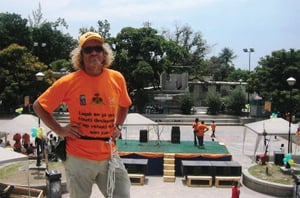A universal language
Katherine Darton talks to Bill Brookman about his work using the arts in conflict zones.

Bill Brookman Productions has always used the arts for rehabilitation. Our first international project was in Gujarat a year after the major earthquake there. We put on street festivals that local people could share, to acknowledge the tragedy but emphasise the importance of hope and joy. Our first conflict zone came after that, when I was asked by a friend who worked for the United Nations (UN) in Kosovo to produce a street festival there after the terrible civil war. We put on a massive show, involving local performers, as a celebration of peace. We were working with Kosovan Albanians for our main show, but I had, on a preparatory trip, gone to rival Serb areas with UN protection and worked with some children there too. We had to keep this quiet in our host Albanian town, where people were still very traumatised by what had happened. There were many physical signs of war there, and we postponed our show for the funeral of villagers who had been brought back from a mass grave to a new cemetery.
After that we went to Sierra Leone, chosen specifically because we wanted to work with amputees. While visiting a possible partner non-governmental organisation (NGO) there, I met a UN representative who asked me if I could think of entertaining ways to encourage people to give up their weapons after the civil war. Well, juggling balls stood in for land mines and guns made out of modelling balloons explode quite nicely: I created a little show using these sorts of ideas. I spent a month or so touring Sierra Leone and training a local performer to carry on with it. The war had been terrible and people were happy to give up their weapons, and we collected quite a pile. We later created another big show as part of a national celebration, ‘De War Don Don’, which included a single-leg amputee blowing fire on an aerial rig, and a man who had had both hands amputated spinning a fire plate.
Meanwhile Daniel, my UN contact there, rang me from his new posting – Haiti. There, the situation was much more challenging: he wanted again to use the arts to promote peace, but unlike Kosovo and Sierra Leone, Haiti had had no war, just a long history of political unrest, violent dictatorships and non-existent local government. It was dominated by armed gangs who lived by kidnap and murder, terrorising the local people, and also the UN who would not enter the ‘red zones’ of Port au Prince. The gangs had no wish to give up their weapons, and were only too ready to use them. I set up a company, Caravane de la Paix (Peace Caravan), using Haitian artists, to tour the country, creating shows with songs, music and short dramas promoting messages of peace and stable community. We soon realised that we needed to go into the red zones unarmed, or we would have no credibility. I, as a ‘blanc’ (a white stranger) sometimes had to be hidden while the team leaders negotiated with gang leaders to enter their territory. Haitians love music and dance so they always welcomed us. This put the armed gang leaders at a disadvantage and we were able to negotiate with them for weapons surrender in exchange for livelihood training. One of our drivers was kidnapped but fortunately escaped, and another was rescued from lynching by UN soldiers. The project lasted for a year, and we estimate that our messages was heard by at least a million Haitians (out of a population of eight million). We performed in schools, prisons and festivals, and ran workshops on community safety. Several of the team have since formed their own performance groups, and when we went back this year to do a street show on the anniversary of the earthquake, many of them came to take part, which was wonderful.
Haiti seemed pretty dangerous at the time, but Daniel’s next UN posting was Somalia, and just as I was looking forward to a quiet period of company work in the UK, he rang again. The Somali name for Peace Caravan is Geediga Nabada, and I again recruited and trained the performers and designed the vehicles, and they set out to tour the country. Unlike Haiti, Somalia has no history of street performance. The nomadic society, based on quarrelling clans, has a strong tradition of poetry but no other arts. Moreover, it is an Islamic country and in fundamentalist areas dance and music are forbidden. I found that the artists I recruited were all relatively old, having grown up at a more liberal time. Political unrest means huge areas of the country are too dangerous to enter. The team are in increasing danger as they travel east, and they have not yet been able to approach the south. They have had several near-misses, including a roadside bomb, and they inadvertently crossed a mine field while escaping another death threat.
Our latest Foundation trip, in February, was a project with Circus Somaliland, funded by Oxfam, to encourage involvement of girls in the circus shows – very difficult in a Muslim country. Our volunteers began teaching them dance, poi and hula hoop. It’s been an amazing journey, and I have learned a huge amount about local cultures, local and international politics, and am still learning. One thing that really surprises me is how few people are sometimes working on very large issues, for example how small and short term the UN’s project budgets are, and how, sometimes, they seem to be feeling their way as much as I am. One thing I regret is not having learned any of the local languages, but the arts are a universal language.
Join the Discussion
You must be logged in to post a comment.